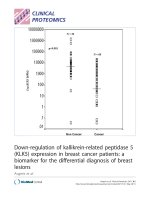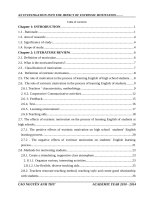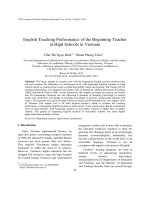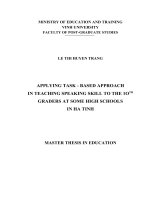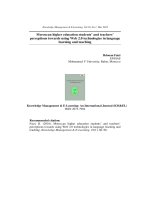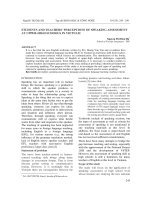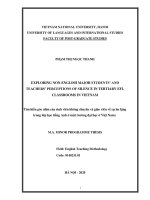Students and teachers'' perceptions of speaking assessment at upper high schools in Vietnam
Bạn đang xem bản rút gọn của tài liệu. Xem và tải ngay bản đầy đủ của tài liệu tại đây (234.45 KB, 6 trang )
Nguyễn Thị Diệu Hà
Tạp chí KHOA HỌC & CÔNG NGHỆ
191(15): 245 - 250
STUDENTS AND TEACHERS' PERCEPTIONS OF SPEAKING ASSESSMENT
AT UPPER-HIGH SCHOOLS IN VIETNAM
Nguyen Thi Dieu Ha*
School of Foreign Languages - TNU
ABSTRACT
It is a fact that the new English textbooks written by Pro. Hoang Van Van and co-authors have
made the context of English language teaching (ELT) in Vietnam an enormous shift from teachercentered to learner-centered which focuses on communication. The introduction of the books,
however, has posed many teachers of English at upper-high schools challenges, especially
speaking teaching and assessment. From those backdrops, it is necessary to conduct studies to
explore teachers and students perceptions of the issue aiming at providing a theoretical framework
for assessing speaking. The purpose of this study is to investigate the task types of speaking and
criteria for speaking assessment that teachers at upper-high schools used to assess speaking.
Key words: perception; speaking assessment; language assessment; language learning; marking criteria
INTRODUCTION*
Speaking has an important role in human
beings life because speaking is a productive
skill in which the speaker produces to
communicate among people in a society in
order to keep the relationship going well.
Speaking is the thing that we use to express
ideas at the same time he/she tries to get the
ideas from others. Rivers [1] says that through
speaking, someone can express his ideas,
emotions, attentions, reactions to other person
and situation and influence other person.
Therefore, through speaking, everyone can
communicate well or express what he/she
wants from other and responds to the speaker.
The teaching of speaking has been neglected
for many years in foreign language teaching,
including English as a foreign language
(EFL), for various reasons (e.g. the strong
influence of the grammar translation method,
lack of English native speaker teachers and
EFL teachers with near-native English
proficiency, large class size).[2]
Statement of problem
The move from teacher-centred to learnercentred teaching style brings along many
changes in assessment format. That is from
discrete points testing to communicative
testing. However, it is seemingly that in
Vietnam there are incongruities between the
*
teaching practice and testing activities. InbarLourie [3] notes that:
The move from an atomized view of
language knowledge to what is known as
communicative competence, and to
communicative and task-based approaches
to language teaching has accentuated the
incongruity of existing assessment measures.
Calls for matching language learning and
evaluation have been repeatedly made since
Morrow (1979) urged language testers over
three decades ago, to bridge the gap between
communicatively focused teaching goals and
the testing procedures used to gauge them.
Textbooks include of speaking sections, but
the types of assessment as well as criteria for
assessment of speaking is not mentioned in
any teaching materials at this level. In
addition, the final exam is paper-based not
oral-based so the assessment of oral English
has not received sufficient considerations.
There have been many attempts to bridge the
gap between teaching and testing, especially
with the approvement of the National Project
2020 and the development of VSTEP.
However, the assessment of speaking skill at
high schools is still a limitation for many
teachers of English at this level in Vietnam.
Scope of the study
The study will focus on the application of
speaking assessment at high school level
whose learners are studying the new national
Tel: 0947 998798, Email:
245
Nguyễn Thị Diệu Hà
Tạp chí KHOA HỌC & CÔNG NGHỆ
textbooks namely English 10 (Tiếng Anh 10),
English 11 (Tiếng Anh 11), and English 12
(Tiếng Anh 12) written by Prof. Hoang Van
Van and co-authors (2018).
Research questions
From the above mentioned aims, the study
attempts to answer the following questions:
What kinds of task do teachers use to
assess speaking at upper-high schools?
What assessment criteria are employed to
assess speaking?
What problems do teachers encounter
when assessing students’ speaking
performance?
LITERATURE REVIEW
Principles of language assessment
According to Brown [4], there are five
principles which are practicality, reliability,
validity, authenticity and washback.
Practicality
An effective test is practical when, it is not
expensive, it stays within appropriate time
constraints, it is easy to administer and it has
a scoring/evaluation procedure that is specific
and time-efficient.
Reliability
Reliability means when the teacher presents a
test and after, she/he gives the same test to the
same student, the test should yield similar
results; it is what reliability consists on.
Validity
Validity is when the results of the test are
appropriate, meaningful, and useful in terms
of the purpose of the assessment. In other
words, a test or task measures what teachers
want to measure.
Authenticity
A test that shows a natural language as is
possible, contextualized items, meaningful
topics and real-world tasks is what shows that
a test is authentic.
Washback
It refers to the effect of assessment on
teaching and learning. Washback gives the
opportunity to teachers and students to give
246
191(15): 245 - 250
feedback to realize problems language
learning and improve them.
Speaking assessment
Speaking and listening, by nature are almost
always closely interrelated. It is very difficult
to isolate oral production tasks that do not
directly involve the interaction of aural
comprehension. Only in limited contexts of
speaking people can assess oral language
without the aural participation of an
interlocutor. As a productive skill, speaking
can be directly and empirically observed.
Brown [4] stated that the interaction of
speaking and listening challenges the designer
of an oral production test to tease apart, as
much as possible, the factors accounted for by
aural intake.
Criteria for speaking assessment
Pronunciation
According to Scott Thornbury [5],
pronunciation is in the CEFR included in an
illustrative scale for phonological control.
Pronunciation is the ability to produce
individual sounds and to link words together,
as well as using stress and intonation to
communicate meaning.
Vocabulary
The CEFR includes illustrative scales
regarding the range of vocabulary knowledge
and the ability to control that knowledge. A
person on the highest level of proficiency
(C2) has “a good command of a very broad
lexical repertoire including idiomatic
expressions and colloquialisms; shows
awareness of connotative levels of meaning”
A person on this level also has a “consistently
correct and appropriate use of vocabulary.”[6]
Grammatical accuracy
In addition to vocabulary, grammar is the
building blocks in a language; the basis one
can construct a language from. All languages
have patterns and rules one must apply in
order to produce language. Bachman &
Palmer [7] state that grammatical knowledge
contains vocabulary, syntax and morphology,
i.e. knowledge of how utterances and
sentences are organized.
Nguyễn Thị Diệu Hà
Tạp chí KHOA HỌC & CÔNG NGHỆ
Fluency
‘Fluency’ is a term that requires further
clarification, as it includes two different
meanings; one general and one technical. The
general meaning covers the ability to speak
various languages, as in ‘she is fluent in five
languages’, whereas the technical meaning is
applied to characterize a student’s speech.
What makes it difficult to assess fluency is
that features such as flow and smoothness in
language, as well as the use of pausing and
hesitation markers are complex; they do not
just describe a person’s speech but also
include the listener’s perception of the
speech. [8]
Turn-taking
In all natural speech more than one partaker is
required, and to keep a conversation going it
is important to manage turn-taking. As stated,
mastering turn-taking is important in spoken
interaction, and the CEFR has described this
competence in two different illustrative
scales.
Types of speaking assessment
Formative and summative assessment
Formative assessment is based on what the
students achieve during the whole course, and
the teacher gives feedback to the students
with the aim of improving learning. The
definition of formative assessment is thus
assessment for learning as opposed to
summative assessment which is assessment of
learning. [9]
Self-assessment
Self-assessment is another assessment method
to employ in the classroom, and it is certainly
assessment for learning as it entails that the
students are concerned about their own
learning progress. Brown [10] defines selfassessment as all assessment that involves the
learners to evaluate their own competence and
performance against a set of criteria.
Criterion-reference assessment
Criterion-referenced assessment means that
the students’ performances are measured
against certain criteria and not against other
student’s performances [11]. The principle of
191(15): 245 - 250
not comparing students to one another is
absolute and very significant. This entails, for
example, that any student may attain the
highest mark if she/he has scored very highly
on all criteria in a test.
Speaking assessment practice in Vietnam
In Vietnam, there have also been many
researches in the field of speaking
assessment. N. H. H. Thuy & T. T. T. Nga
[12] explored EFL teachers’ perceptions of
in-class English speaking assessment. The
constructs
of
teachers’
perceptions
investigated in the current research included
their general understanding of speaking
assessment, the task types of in-class
speaking assessment, and the teachers’ work
involved in the assessment implementation.
Phan. N.H.N [13] has mentioned some
constraints in English language teaching in
Vietnam in her research. One of which stems
from the exam-oriented curriculum, the
teaching practice focuses on receptive skills
only. She carries out some interviews for her
qualitative research and the finding is that
two-thirds of the participants indicated that
their students did not have any opportunities
to practise their English, and or to interact
with different speakers from all over the
world. As a result, they were quite bookish
and were not really motivated to learn
English.
N. H. H. Thuy & T. T. T. Nga [12] conducted
a study to investigate EFL teachers’
perceptions of in-class English speaking
assessment. The constructs of teachers’
perceptions investigated in the research
included their general understanding of
speaking assessment, the task types of inclass speaking assessment, and the teachers’
work
involved
in
the
assessment
implementation.
Speaking in the new textbooks in Vietnam
As mentioned in the previous part, the
assessments of oral proficiency in Vietnam,
using the new textbook by Prof. Hoang Van
Van have posed many constraints for teachers
of English at upper-high schools. At upperhigh schools, the English curriculum consists
247
Nguyễn Thị Diệu Hà
Tạp chí KHOA HỌC & CÔNG NGHỆ
of three courses, namely English 10, English
11 and English 12. Each course utilizes one of
the three textbooks in the series, which are
Tiếng Anh 10, Tiếng Anh 11 and Tiếng Anh
12; and is taught in 105 45-minute periods,
which makes the total amount of time for the
whole curriculum 315 periods (approximately
236 hours).
METHODOLOGY
The research design
In this study, the qualitative research design is
selected as the main approach to conduct the
study because the main aim is to investigate
the types and criteria that teachers at upper
high schools used to assess speaking.
Participants
126 students from three classes in Luong
Ngoc Quyen, Chu Van An, and Dong Hy
upper-high schools were selected to
participate in the study. 15 teachers of English
at three high schools were invited to answer
questions in the questionnaires and giving
response in semi-structured interviews to
explore possible problems they may have
when conducting speaking activities and
assessing practice.
Procedures
The data collection process was carried out in
two stages for a period of about 12 weeks.
The questionnaire was carried out first, and
then the interviews were carried out at each
school, first the teacher interview followed by
the student interviews.
RESULTS AND DISCUSSIONS
Results from questionnaires for students
How often do you have speaking test?
There are 70 answers as hardly ever, that
takes up about 55% of the total. 36 answers as
sometimes that accounts for 28.5% of the
total. 20 answers as once or twice a term that
accounts for 15.8 % of the total. Data
obtained from the first question shows that
most of the students hardly ever have
speaking test during the school terms.
What types of task you are required to do?
There are 80 answers as questions and
answers, which accounts for 63.5% of the
248
191(15): 245 - 250
total. 20 answers for read aloud task which
takes up 15.8% of the total. 10 students said
that they played in roles which accounts for
7.9% of the total. Few answers for the other
options. The data reveals that teachers used
questions and answers mostly when they
conduct speaking task types.
Do you know how you are assessed?
126 responses are negative. That means
students do not know on what criteria they are
assessed during the speaking test. That also
means that they do not know what to focus on
while doing the speaking test.
Do you like speaking test?
92 students said they do not like the speaking
test, which is 73% of the total. 12 answers are
positive. That means only 9.5% of the
students said that they like speaking test. 24
answers are negative which accounts for
17.4%. The data shows that most of the
students do not like the speaking test.
Do you think that speaking ability is more
important than other language skills?
The answers are surprising that 112 students
said that other skills are more important
which takes up 89% of the total. Only 3
students said that speaking is more important
that accounts for only 2.3%. 15 students did
not have an idea about the importance of
speaking.
Results from questionnaires for teachers
Have you had any trainings about
assessment?
12 out of 15 teachers said that they have very
limited
knowledge
about
language
assessment, which takes up 80% of the total.
Only one teacher said that she had learned
about assessment at university but did not
remember much about it. Two of the teachers
said that they studied English in an in-service
program so they did not learn about language
assessment. The data show that teachers at
upper-high schools have very limited
knowledge about language assessment in
general and speaking assessment in particular.
What are the types of task do you use to
assess speaking?
Nguyễn Thị Diệu Hà
Tạp chí KHOA HỌC & CÔNG NGHỆ
10 teachers said that they just used questions
and answers as the popular task type (67%).
Three teachers said that they used role-play
tasks (20%). Two teachers said that they used
other types of task. The data shows that
teachers used just few task types. Most of the
tasks are responsive type.
What criteria do you use to assess speaking
ability?
8 out of teacher said that the speaking
assessment criteria are on grammar and
vocabulary (53%). Four teachers said that
they used both macro and micro criteria when
marking students. Three teachers said that
they give marks holistically that means they
combined varieties of criteria of assessment.
The data reveals a fact that teachers take
serious attentions on grammar when assessing
non-grammar aspects of language.
Do you know about these types of speaking
assessment?
Only two teachers know a little bit about
criterion assessment because they had just
took an exam on CEFR. Most of the
interviewers have no ideas of the listed
speaking assessment.
Results from interviews
Three teachers of English at different schools
are selected for the semi-structured interview.
They are selected because they have just
passed the C1 level exam and they seemed to
have better understanding of speaking task
types and assessing speaking criteria. The
researcher asked the first teacher some
questions about problems she encountered
when conducting speaking assessment. She
confessed that she does not do many speaking
activities as well as speaking test while
teaching. The reason for that is that the
students are not interested in speaking. They
just want to do the written test to strengthen
grammar and reading ability. The other
reason is that the large class size prevents her
from doing speaking activities. She wants to
teach a smaller class so that she can help
students develop oral skills.
The second teacher said that he ignores most
of the speaking activities in class because he
191(15): 245 - 250
did not have enough time to do the task.
Besides, he has limited understanding about
language assessment. He would like to attend
a course specified on language testing and
assessment.
The third teacher said that she is aware of the
importance of speaking skill and she really
want to help students to talk in the class but
the constrains of the curriculum prevents her
from doing time-consuming speaking
activities. She said that she expect some
changes in the way of graduation exam so that
the focus of teaching will be on oral skills.
CONCLUSION
By conducting a research to investigate
speaking practice at three upper-high schools
in Thai Nguyen province with 126 students
and 15 teachers of English, the conclusion is
that:
Teachers do not spend much time and
energy on the speaking skill. In other
words, the focus of teaching is not on oral
communication just because of the exambased curriculum.
Teachers do not have sufficient
understanding of speaking and assessment
as well as speaking task types.
Implication
The influence of the exam-based curriculum
has had bad washback on both teaching and
learning of oral skills at upper-high schools.
This is the cause of unbalanced attention has
been paid to teaching and learning of
speaking and listening which are the main
attentions of communicative teaching. In
coming years, there should be alternative
forms of assessment for those who expect to
develop their oral skill. One of the possible
solutions is that we can have oral exams
through out the school year. Those who gain
good achievement in those exams will not be
required to take the final exam for graduation,
or they may still sit for the exam if they want
some plus marks for the other subjects. There
should be changes in the way language is test
in the final exam so that the focus of teaching
shift from exam-based to competence based
to develop full language ability.
249
Nguyễn Thị Diệu Hà
Tạp chí KHOA HỌC & CÔNG NGHỆ
REFERENCES
1. Rivers, Wilga. M. (1987). Interactive Language
Teaching. New York: Cambridge Language
Teaching Library.
2. Nation, I. P. (2011). Second language speaking.
In E. Hinkel (ed.), Handbook of research in
second language teaching and learning (pp. 444454). New York, NY: Routledge.
3. Inbar-Lourie, O. (2008). Constructing a
language assessment knowledge base: a focus on
language assessment courses. Language Testing,
25: 385-402.
4. Brown. H. Douglas. (2004). Language
assessment: Principles and classroom practices.
White Plains, NY. Pearson Education.
5. Scott, Thornbury. (2005). How to teach
speaking. Pearson Education
6. Council of Europe. (2001). Common European
Framework of Reference for Languages:
Learning, Teaching, Assessment. Council of
Europe,
Modern
Languages
Division,
Strasbourg/Cambridge: Cambridge University
Press.
191(15): 245 - 250
7. Bachman, L.F. & Palmer, A.S. (1996).
Language Testing in Practice. Oxford: Oxford
University Press.
8. Louma, S. (2003). Assessing Speaking
(Cambridge Language Assessment). Cambridge:
Cambridge University Press.
9. Fulcher, G. & Davidson, F. (2007). Language
Testing and Assessment an advanced resource
book. Routledge Taylor & Francis Group, London
and New York.
10. Brown. H. Douglas. (2001). Teaching by
Principle: An Interactive Approach to Language
Pedagogy. New York: Longman.
11. Simensen, A.M. (1998). Teaching a Foreign
Language Principles and Procedures. 2nd edition
Fagbokforlaget Vigmostad & Bjørke AS, Bergen
12. N.H.H. Thuy & T.T.T. Nga. (2017). An
investigation into EFL teachers' perceptions of inclass speaking assessment. VNU Journal of
Foreign Studies, (Vol.34), No.2, 125-139.
13. Phan. N.H.N. (2014). Challenges/constraints
in teaching today's English in Vietnam: Teachers'
voice. Conference proceeding.
TÓM TẮT
NHẬN THỨC CỦA GIÁO VIÊN VÀ HỌC SINH TRONG VIỆC ĐÁNH GIÁ
KỸ NĂNG NÓI TẠI CÁC TRƯỜNG THPT Ở VIỆT NAM
Nguyễn Thị Diệu Hà*
Khoa Ngoại ngữ - ĐH Thái Nguyên
Thực tế cho thấy bộ sách giáo khoa tiếng Anh mới được biên soạn bởi GS. Hoàng Văn Vân và các
cộng sự đã tạo ra một sự chuyển biến lớn trong bối cảnh giảng dạy tiếng Anh ở Việt Nam từ định
hướng lấy người dạy làm trung tâm sang lấy người học làm trung tâm, tập trung vào khả năng giao
tiếp. Tuy nhiên, việc sử dụng bộ sách đã đặt ra nhiều thách thức cho giáo viên dạy tiếng Anh tại
các trường trung học phổ thông, đặc biệt là việc dạy và đánh giá kỹ năng Nói. Từ bối cảnh trên,
chúng tôi nhận thấy cần có những nghiên cứu nghiêm túc để tìm hiểu cảm nhận của giáo viên và
học sinh về vấn đề đó nhằm tạo ra một khung lý thuyết cho viêc đánh giá kỹ năng Nói. Mục tiêu
của nghiên cứu này là điều tra các loại loại hình bài tập mà giáo viên sử dụng cũng như các tiêu
chí để đánh giá kỹ năng Nói.
Từ khóa: nhận thức; đánh giá kỹ năng Nói; đánh giá ngôn ngữ; học ngôn ngữ; tiêu chí đánh giá
Ngày nhận bài: 12/12/2018; Ngày hoàn thiện: 26/12/2018; Ngày duyệt đăng: 28/12/2018
*
Tel: 0947 998798, Email:
250


